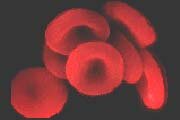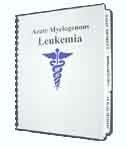 |
||
| HOME | ||
 |
||
| Acute Myelogenous Leukemia (AML) |
||
 |
||
| Other Leukemia Types (ALL / CLL / CML / HCL) |
||
 |
||
| Myelodysplastic Syndrome | ||
 |
||
| Symptoms and Diagnosis | ||
 |
||
| Leukemia Treatment Options | ||
 |
||
| " Chemotherapy | ||
 |
||
| " Blood Stem Cell Transplants | ||
 |
||
| " Radiation and Surgery | ||
 |
||
| " Chemo Side Effects | ||
 |
||
| " Clinical Trials Info | ||
 |
||
| " Coping with Leukemia | ||
 |
||
| " What to Ask Your Doctor | ||
 |
||
| Financial Assistance | ||
 |
||
| At Risk Jobs/Exposure | ||
 |
||
| Leukemia Resources | ||
 |
||
| Survivor's Story | ||
 |
||
| Leukemia News | ||
 |
||
|
Search for information:
|
||

|
Leukemia Cancer News - Return to Menu 'Miracle' survivor gets trip to D.C. BY KATHLEEN FORDYCE March 16, 2005 - Shea Garcia will be missing a few days of kindergarten this week. But his teachers are sure to excuse his absence. Shea, who has spent most of his five years of life in Miami Children's Hospital fighting leukemia, will be touring Capitol Hill as a Florida ambassador for the Children's Miracle Network. He will be one of 50 children, one from each state, to visit the White House and meet U.S. senators and singer LeAnn Rimes. Shea is ready for the much-deserved vacation. He has a new camera -- a gift from the hospital's foundation -- and he knows exactly what he wants a picture of: ''George Bush and snow,'' he said shyly. Shea will travel with his parents, Eddie and Ayo Garcia, and his older brother, Omari. ''December 30, 1999, is probably the day we will never forget,'' said Eddie Garcia, speaking of the day Shea was diagnosed with acute myelogenous leukemia -- one of the most aggressive forms of leukemia. ``We lost our son four times, and the Lord and the hospital gave him back to us four times.'' After he was diagnosed, Shea had chemotherapy treatments for about five months. But in December 2000, Shea relapsed and had to go back on chemotherapy. Just seven months later, he relapsed for the second time and his doctors decided he would need a bone-marrow transplant. A donor was not easy to find, since his family members were not matches. Once placed on the national registry, it took four months before a donor was found in Tampa. After the transplant, Shea became sick with the CMV virus, which causes infection after transplantation and can cause pneumonia and organ complications. Less than two years later, Shea was diagnosed with a tumor in his nasal cavity. He underwent more chemotherapy and when that didn't work, he received lymphocytes from the same donor in Tampa. ''We practically lived in the hospital,'' Shea's mother recalled. ``But it didn't bother him. He actually likes going to the hospital. It's where he grew up.'' Now, Shea only goes to the hospital for check-ups. The youngster is still taking many medications because of his low immune system. ''But that is just minor stuff,'' Ayo Garcia said. ``We can deal with that.'' Dr. John A. Fort, the director of bone-marrow transplantation at Miami Children's Hospital and one of the doctors who treated Shea, said the 5-year-old is in remission and doing well, but his doctors will still monitor him. ''We'll watch him for years to come,'' Fort said. Shea was chosen for the Children's Miracle Network's program -- Foresters Champions Across America -- because of his experiences at the hospital. The network is a nonprofit organization that raises funds for children's hospitals across North America, and Miami Children's is a member of the network and nominated Shea for the program. In the meantime, the Garcia family is just excited to have a vacation. ''We just happen to be fortunate to have Shea here with us today,'' Eddie Garcia said. ``I think it's a miracle from God.'' Valproic Acid May Increase Chemotherapy Response NEW YORK PAR 11, 2005 (Reuters Health) - Valproic acid affects healthy hematopoietic stem cells (HSC) in a manner that is distinctly different from that exerted on leukemic cells. Reporting in the April 1st issue of Cancer Research, German researchers suggest that by stimulating proliferation of HSC, valproic acid could increase cancer patients' response to conventional chemotherapy. Valproic acid is a histone deacetylase inhibitor previously suggested for treatment of acute myeloid leukemia (AML) and other cancers (see Reuters Health reports, January 6, 2005 and December 27, 2001). Studies had shown that the agent selectively induces differentiation and apoptosis of leukemia cells. The research team, led by Dr. Martin Ruthardt, has found that "patients responding to this therapy frequently developed constant or increased bone marrow cellularity despite a remarkable blast cell reduction and peripheral hypergranulocytosis." For their current report, Dr. Ruthardt and colleagues at Klinikum der Johann Wolfgang Goethe-Universitat in Frankfurt investigated the effects of valproic acid on normal cultured hematopoietic stem cells. In contrast to AML cells, valproic acid increased the proliferation of human CD34+ HSCs, but prevented them from differentiating into CD14+ cells. The agent also enhanced the replating efficiency of the cultured cells, suggesting that their self-renewal potential was enhanced. This was confirmed when valproate-treated stem cells were injected into lethally irradiated mice, and their spleen size was increased compared with control animals or those inoculated with all-trans retinoic acid. Valproic acid was also found to accelerate cell cycle progression by increasing the percentage of cells in S phase and reducing those in G1 phase. This process was apparently effected by inhibiting glycogen synthase kinase (GSK)-3-beta, the authors report. "The valproic acid-induced entry of quiescent hematopoietic and leukemic stem cells into the cell cycle could render them more susceptible to conventional chemotherapy, resulting either in a prolonged aplasia due to a higher efficiency of the therapy or in a shortened aplasia owing to the enforced proliferation of the normal hematopoiesis," Dr. Ruthardt's team concludes. SOURCE: Cancer Research 2005;65:2537-2541. |
|
|


